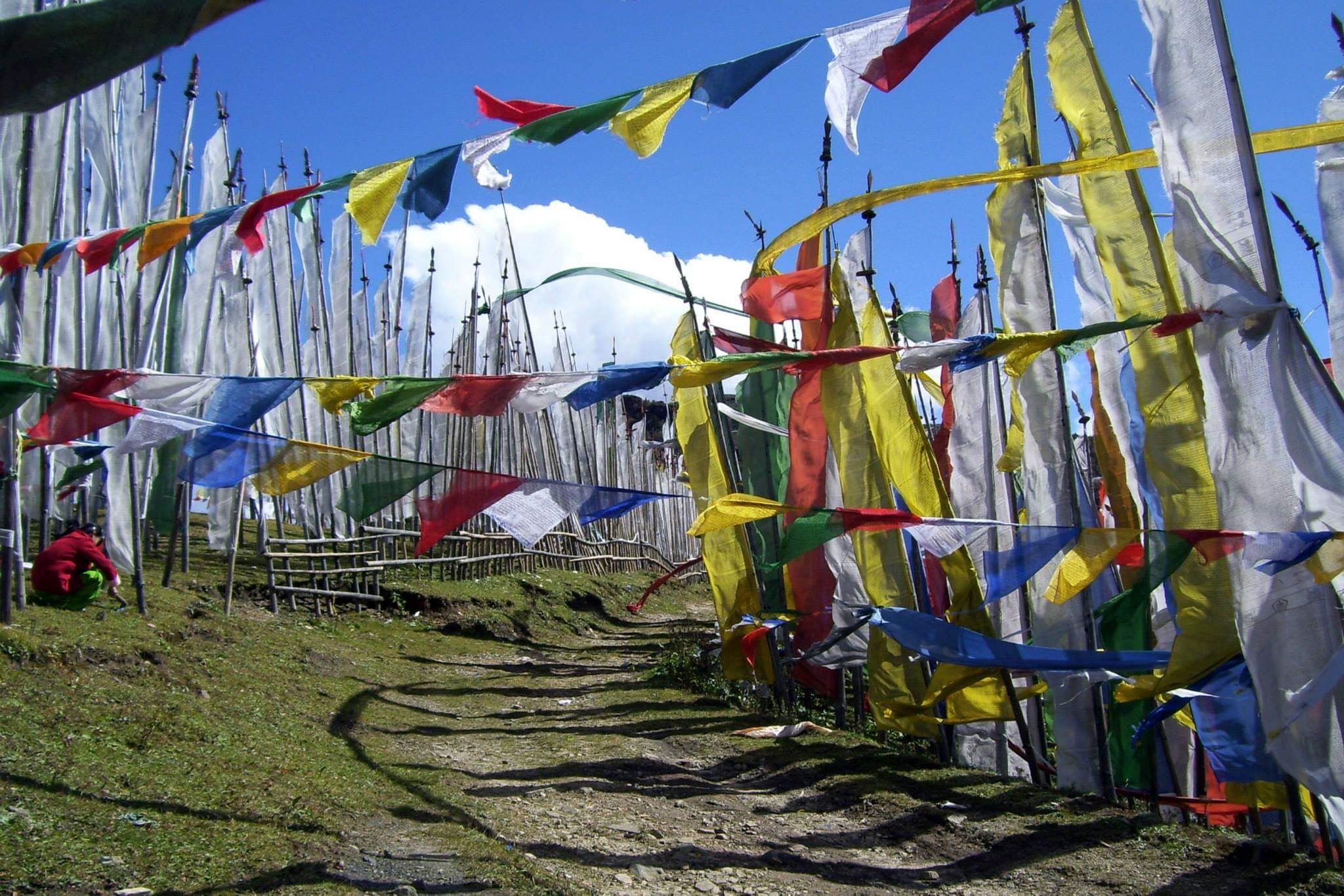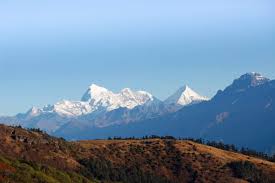- +
Day 1
Arrive in Paro, Transfer to the Thimphu Valley
Landing in the Paro Valley is like entering another world. Cultivated fields cover most of the valley floor, and hamlets and isolated farms dot the landscape. After arrival, your Bhutanese guide will meet you and accompany you to the capital, Thimphu, located in a large valley and overshadowed by high peaks. It's about an hour's drive from the airport. Choose to rest, or visit a few points of interest, depending on your time of arrival. Good places to start sightseeing in Thimphu are the Memorial Chorten and Kuensel Phodrang. In the evening, take a walk along Thimphu's high street and get a feel for the culture of this small capital city.
- +
Day 2
Thimphu Sightseeing
Today, explore Thimphu according to your interests. The following are options, although you don't need to include them all: Institute of 13 Arts and Crafts of Bhutan (Institute for Zorig Chusum). Opened in June 1997, the institute reflects Bhutan’s effort to provide opportunities for vocational training. Bamboo and wood crafts are especially popular in this region. Kuensel Phodrang (Buddha Point). Where the Buddha Dordenma resides, this is said to be one of the largest Buddhas in the world, standing 169 feet (51.5 m.) tall. Look down on Thimphu from the viewpoint. School of Astrology (Pangri Zampa Lhakhang). Bhutanese parents visit this Lhakhang to get blessings for their newborns. Built in the 16th century, the Lhakhang consists of two temples. Post Office. Philatelists will be interested in the museum attached to the post office. Five galleries trace the development of the Bhutanese postal system, from the earliest mail runners to Bhutan's idiosyncratic and highly collectible modern stamps. Most importantly, you can get your photo printed onto a Bhutanese Stamp and then mail it back home to your friends. Folk Heritage Museum. This museum gives you a glimpse into traditional Bhutanese life. It displays an impressive collection of typical household objects, tools, and equipment. There are regular demonstrations of rural traditions, skills, habits, and customs, as well as educational programs for children. Royal Textile Museum. This is the place to learn about Bhutan's living national art of thagzo (weaving). The ground floor focuses on royal ghos, including the wedding clothes worn by the fourth king and his four wives. The upper floor introduces the major weaving techniques, styles of local dress, and textiles made by women and men. The museum shop offers some interesting books and fine textiles. Tashichho Dzong. Also known as the ‘fortress of the glorious religion’, this dzong was initially built in 1641, and later rebuilt in its present form by King Jigme Dorji Wangchuk in 1965. The Dzong houses the main secretariat building with the Throne Room of His Majesty the King of Bhutan. The National Assembly Hall is housed in a modern building on the other side of the river.
- +
Day 3
Drive Thimphu to Gangtey
Leaving Thimphu, head into the countryside toward the Gangtey Valley, home of the rare blacked-necked cranes. The drive ascends gradually to the Dochula Pass, which is over 10,300 feet (3,139 m.). There are magnificent vistas of the Himalayan range from the pass. Located near the pass is the Dochula Monastery, a tribute to the service and leadership of the king. It's a unique cluster of 108 chortens and is an attractive place to stop and take some photos. The descent to Wangduephodrang is vibrant and colorful, with fluttering prayer flags adding to the rich landscape of terraced farms and rivers. Wangduephodrang is the last town on the highway before you enter central Bhutan. Wangdue Dzong was lost to a devastating fire and is being rebuilt. You can choose to stop at a viewpoint where you can see the ruins of the dzong. Continue toward the Phobjikha Valley, a wide glacial valley with a central stream meandering through open grassland and thickets of dwarf bamboo. Farmland occupies slopes where potatoes and turnips are grown. The forest beyond the farms is mostly coniferous, with blue pine, birch, maple, and several species of rhododendrons. The local cattle and horses graze on the bamboo, preparing the ground for the cranes that come in winter.
- +
Day 4
Gangtey Sightseeing
After an early breakfast, begin a day of sightseeing and hiking in the Phobjikha Valley. Here are some of your options today: Black-necked Crane Centre: These birds are named Thrung Trung Karmo in Bhutan, and are the subject of Bhutanese songs, art, and folklore. They are an endangered species, and migrate from Tibet in late autumn, typically staying in Bhutan until mid-March. About 300-400 cranes reside in the wetland in the center of the valley. The Observation & Education Centre has informative displays about the cranes and the conservation efforts in the valley. Gangtey Gompa: This monastery sits atop a hillock that overlooks the Phobjikha Valley. It was founded in 1613, but newer buildings have been added. Gangtey Nature Trail: This pleasurable walk will give you a good sense of the Phobjikha Valley. From the small hilltop overlooking Gangtey Gompa, head downhill through flower meadows to Simchubara Village, and from here through beautiful forest and into the open valley. After passing a chorten and Khewa Lhakhang, the trail ends at the Tabiding football ground. You can also start your hike from the lodge, which involves a 30-minute walk up to the Gangtey Monastery. The walk is approximately two hours.
- +
Day 5
Gangtey to Punakha via Chimmi Lhakang and Punakha Dzong
Today, head to the Punakha Valley, the old capital of Bhutan. On the way, explore the valley and a couple of attractions. First, Chimmi Lhakang. Traverse the Punakha countryside, walking through paddy fields to Pana Village to see Chimi Lhakhang, built in 1400 to subdue local demons. The temple is a popular pilgrimage spot and is especially revered by women for its fertility powers. Later, check out Punakha Dzong. This dzong sprawls at the confluence of the Phochu (male) and Mochu (female) rivers. It was built in 1637.
- +
Day 6
Punakha Hike, Drive to the Paro Valley
Set out early for a day hike to Khamsum Yulley Namgyal Monastery. A 30-minute drive from the Punakha Dzong will bring you to the base of the hill on which this temple is built. From the car park, cross a suspension bridge and walk through rice fields before climbing a moderately inclined trail surrounded by pine trees. From the temple, it takes about an hour to hike up the temple and half an hour to hike down. After lunch, continue toward the Paro Valley, a 3-4 hour drive, via the Dochula Pass.
- +
Day 7
Chele La Pass & Kila Goemba Hike
Start with a drive to Chele La Pass, the highest road pass in Bhutan (12,500 feet/3800 m.), snaking upwards through blue pine and rhododendron forests. On a clear day, the view sweeps away to the snow-dome of Bhutan’s second-highest peak, Mt. Jhomolhari, on the border with Tibet. Begin your hike by striding out along the edelweiss-covered ridge, passing a sky burial site. Descend for a two-hour hike through dense rhododendron forest, possibly sighting shaggy yaks, to Kila Goemba, an ancient nunnery nestled in a craggy patch on the mountainside below. Kila Goemba is a serene retreat for 32 Anim (Buddhist nuns) who lead an undisturbed life of religious study, prayer, and meditation. The nunnery is one of the seven oldest nunneries in the kingdom. Dupthob Chhoeje Norbu and Dupthob Temba established it in the early ninth century as a place for meditation. After making offerings, it is time to descend further and then drive back to the Paro Valley. The hike is of moderate difficulty and takes 2-3 hours.
- +
Day 8
Paro Sightseeing
Today is devoted to exploring quaint Paro and its surrounding areas. Your sightseeing itinerary can include: Paro Dzong. Also called Rinpung Dzong, or the Fortress of a Heap of Jewels. Constructed in the early 15th century as a diminutive fort, it was developed into a much more commanding fortress in 1646. This is one of the kingdom’s finest examples of traditional Bhutanese architecture. Once, great catapults here flung stones at invading Tibetans. Today it houses a monastic school. Ta Dzong. This watchtower was built in 1649 to protect the undefended dzong, and renovated in 1968 to house the National Museum. The unusual round building is said to be in the shape of a conch shell. Displays include an impressive collection of thangkas, both ancient and modern, depicting Bhutan's important saints and teachers, as well as fearsome festival masks grouped according to their tsechu dances. There's a natural-history gallery with a 3D map of Bhutan, while the Heritage Gallery contains such oddities as an egg laid by a mule and a horse horn attributed to Guru Rinpoche. Kyichu Monastery. This is one of the oldest monasteries in the country, built in the 7th century by Tibetan King Songsten Gampo. The story goes that a giant demoness lay across the whole area of Tibet and the Himalayas and was preventing the spread of Buddhism. Butter lamps are the most powerful offering because their light symbolizes wisdom. Just as a lamp dispels darkness, offering light from a butter lamp represents removing the darkness of ignorance to attain Buddha's luminous clear wisdom. Drugyel Dzong ruins. The name means victorious fortress, and it was built in 1644-49 to commemorate the Bhutanese victory over the Tibetan-Mongol forces. In 1951 it was engulfed in fire by accident. On a clear day, Mt. Jhomolhari, Bhutan's holy peak, can be seen from here. If you'd rather get active than embark on general sightseeing, today you can choose to hike to Drakharpo Monastery. After a short drive from Paro, hike for about 90 minutes to the monastery, which has a small community of monks living nearby. The main temple room is precariously perched on the edge of a rocky cliff. There are some sacred sites to view, including the body imprint of Vajrayogini and a stone boot belonging to Guru Rinpoche. The monastery is built on a mountain dotted with underground caves.
- +
Day 9
Hike to Tiger's Nest Monastery
After breakfast, drive for about 25 minutes to begin your hike to one of Bhutan’s most revered pilgrimage sites, the Taktshang Lhakhang, popularly known as the Tiger’s Nest Monastery. The trek offers spectacular views of this sacred monastery, which is perched precariously on a sheer rock face 3,000 feet (900 m) above the valley floor. Legend has it that Guru Rimpoche, father of Bhutan's stream of Mahayana Buddhism, arrived in the Paro Valley more than a millennium ago on the back of a tigress. He meditated for three months in a cave, which was converted into this monastery. The hike from the base to the cafeteria will take at least 90 minutes. From there, it’s about an hour’s trek through some stunning landscape to reach the monastery. On the return, stop once more at the cafeteria for lunch. The trek is moderate and takes 2-3 hours in total. Ponies are available for the uphill portions at an additional cost.
- +
Day 10
Depart Bhutan
You'll be transferred to Paro International Airport in good time for your flight. Tashi Delek! We hope you will visit us again.






 Dear
Dear
 Dear
Dear Dear
Dear






